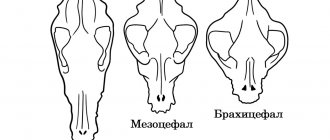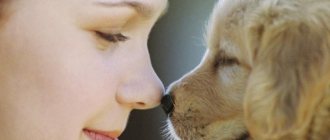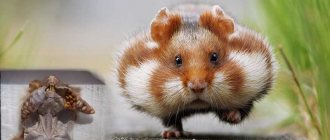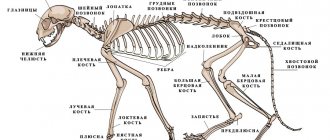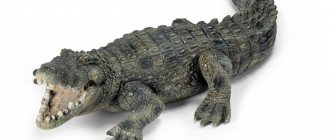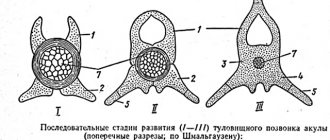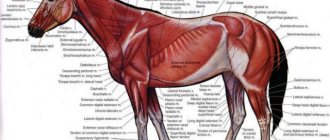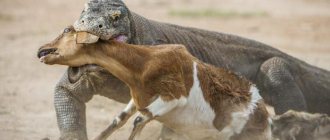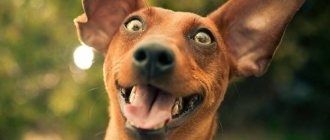general characteristics
To make it easier to understand the anatomy of a dog, the dog’s body parts are conventionally divided into four main components, namely:
- head. This part includes the brain and facial zones, as well as the sensory organs;
- neck. There are upper and lower regions;
- torso. This category is more expanded and is considered from the withers to the tail;
- limbs. This category includes the front and hind legs.
Unfolded skeleton of a dog
The external characteristics of the dog, its body parts and their location, which are inherent in the breed and gender, are called the exterior and look like the signature of the breed.
Note! In addition to the general idea, it would not hurt for the dog owner to study the textbook, authored by Volmerhaus and Frewein, which provides a diagram and location of all the animal’s organs. The practical textbook is regarded as a guide for dog breeders.
Scull
The dog’s skull is light, with a developed brain part; depending on the breed, the shape of the skull can vary greatly, with 3 main types:
The bones of the skull form the walls of the brain, oral and nasal cavities to house and protect soft organs (brain, sensory organs, initial parts of the respiratory and digestive systems). The bones of the head serve as extensive surfaces for attaching the chewing and facial muscles.
The head skeleton can be morphologically divided into:
Functionally, the head skeleton can be divided into two sections:
Skeleton or skeletal system
Cat skeleton: anatomy, skull, structure
Of course, the study of dog anatomy begins with the structure of the dog’s skeleton. The skeleton of a dog is the basis on which all the internal organs and muscles of the dog exist. Each component of the skeleton requires special consideration.
Dog skull: structure
There are facial and brain parts, which contain paired and unpaired bones.
Paired dice:
- frontal;
- parietal;
- temporal;
- incisal;
- lower jaw;
- nasal;
- palatal;
- zygomatic;
- maxillary;
- lacrimal
Expanded dog skull with explanations
Unpaired bones:
- interparietal;
- lattice;
- wedge-shaped;
- sublingual;
- vomer;
- pterygoid;
- occipital
Important! The dog's skull consists of 27 bones, which are connected by cartilage tissue. The older the pet, the more the cartilage becomes ossified, and only the lower jaw retains mobility of the head.
There are 3 types of dog skulls:
- dolichocephalic. Representatives are Italian greyhounds, greyhounds, etc.;
- brachycephalic. In this case, it is a pug, a dwarf spitz, a Yorkshire terrier, a chihuahua, etc.;
- mesocephalic. It is found in huskies, shepherd dogs, as well as in the dachshund breed, etc.
For your information! The third type makes up approximately 75% of all breeds.
The differences become visible in the structure of the front part. So, for example, in brachycephalic breeds the muzzle has a flattened shape, and the jaw protrudes forward. This structure of the dog affects its health. In veterinary medicine, the main cause is related to the respiratory tract.
Limb structure
A dog's paws have a complex structure. So:
- the pads serve as shock absorbers. They reduce the stress on the dog's bones and joints and allow him to maintain balance. The pads contain a significant layer of adipose tissue, thanks to which animals do not freeze even in the coldest weather;
- there are phalanges on the fingers, and their description deserves separate consideration. So, 4 fingers have 3 phalanges, and 1 has only 2. There are five fingers on the front paws, and four on the hind paws. There are also vestigial toes, that is, external ones, which are located on the hind legs above the foot. There is no stress on them, but they characterize the quality mark of some dogs, for example, Briards, Beaucerons.
Important! The owner should monitor the condition of the pet's nails especially carefully. So, too long nails interfere with walking and can even deform the skeleton.
Beautiful dog paws enlarged
Body structure
The dog's body includes the vertebral section and ribs, which are connected to each other. A skeleton is attached to all this. The dog's spine consists of four components:
- cervical vertebrae;
- thoracic region;
- lumbar region;
- the sacrum, which extends to the tail and anus.
Spine structure
The pet's body consists of a torso axis and ribs that form the skeleton. The spine is formed from several sections:
- cervical;
- chest;
- lumbar;
- sacral.
At the base of the tail there are 20-23 movable vertebrae. It is the ribs that protect the heart and lungs and, depending on the type of breed, have different curvature. The lumbar vertebrae are large, due to which muscles and tendons are securely attached to them.
For your information! Many dog breeders are often interested in how many ribs a dog has. The chest consists of 13 pairs of ribs.
Structure of teeth
The teeth are used to grind the food received and protect the owner. Dogs are born without teeth. They erupt only at the age of 2-3 weeks. The tooth that appears during this period is temporary. It falls out at the age of 4-5 months, and only after that permanent ones begin to appear.
A set of teeth is formed by:
- incisors. There are 6 of them. on each jaw;
- fangs - 2 on both jaws;
- premolars. There are 4 of them on both jaws;
- two molars on each side of the upper jaw and three lower.
General view of the teeth of an adult dog
Dog skull: structure
The skull consists of cranial (cerebral) bones (forming the cranial or cerebral cavity) and facial bones. The brain section of the skull is formed by unpaired and paired bones. The facial part is wedge-shaped, the lower jaw is attached to the skull. The facial part of the skull also has unpaired and paired bones.
All the bones of the medulla are connected by cartilage or connective tissue in the form of sutures. In older dogs, the sutures become stiff. Only the lower jaw is connected by a movable joint, thanks to which the dog chews food.
Paired dog skull bones:
Unpaired skull bones:
Thus, the dog’s skull consists of 20 paired and 7 unpaired bones.
Side view of dog skull:
Dog's dental system and bite
Consists of incisors, clicks, false roots, molars, premolars and molars (42 teeth in total). The breed standard determines the correct bite of a dog. The bite may be:
Sense organs or analyzers
Perhaps every dog owner knows that such animals hear better than any person. And the dog’s sense of smell is at the highest level. But you need to have a more detailed understanding of each sense organ.
Ear structure
Dog vagina, penis: structure of the genital organs
The sound reaches the pet through the outer ear, and then it moves to the middle ear and ends up in the inner ear. The outer one consists of the auricle, thanks to which he hears even the quietest sounds. Following the auricle is the auditory canal, which consists of several parts:
- horizontal;
- vertical.
The eardrum plays an important role in the hearing system, thanks to which acoustic waves are heard. The middle ear contains the auditory bones of the dog, thanks to which the eardrums and inner ear are attached to the membrane.
For your information! The inner ear provides auditory receptors and contains the vestibular apparatus.
Close-up view of a dog's ear, implementation of auditory activity
Structure of the nose
The nose allows the dog to have a connection with the outside world. The animal reacts sharply to the smell, which allows it to be used not only for peaceful, but also for official purposes. The animal remembers the smell of its owner and recognizes it, even when for some reason it cannot see it.
Important! There are 125 million olfactory receptors in animals, but only 5 million in humans.
The dog senses smells through his nostrils. The pet receives a large percentage of air through the side cutouts on the nose. There is also mucus in the nose, which is why it remains moist.
It consists of the external nose and the nasal cavity, which includes several parts. The upper one is the repository of olfactory reflexes. The lower one serves as a connecting link through which air enters and passes to the nasopharynx, where it warms up.
Labradors have a heightened sense of smell
Structure of the eye
The eye consists of the cornea, lens and retina. Unlike the human visual organ, it is not equipped with a macula. This makes a dog's vision slightly worse than a human's.
Note! Compared to humans, animals see much better in the dark.
The dog sees with the help of the cornea, into which a beam of light passes. Then it enters the retina.
Brown-eyed dog: enlarged image of the eye
Front and rear limbs
The dog's forelimb is formed by an obliquely set shoulder blade, which connects to the humerus with the help of the glenohumeral joint. The elbow joint is the connection of the forearm (from the radius and ulna) and the humerus. The carpal joint consists of 7 carpal bones, which are connected to the metacarpus (5 bones). The metacarpus goes into 4 three-phalangeal and 1 two-phalangeal fingers. The fingers have non-retractable, strong claws.
The dog's hind limb is represented by the hip joint, which connects the limb itself to the pelvis. The hind limb is formed by the femur, which is connected to the lower leg with the help of the knee joint (2 bones - the tibia and the tibia). On the other side, the tibia is connected to the tarsus using the hock joint. The tarsus consists of tarsal bones, among which the powerful heel bone stands out. 4 (occasionally 5) metatarsal bones are attached to the tarsus. They form a metatarsus, which then turns into 4 3-phalanx fingers with claws.
The forelimb is connected to the spine with the help of powerful shoulder muscles, and the upper edges of the shoulder blades slightly exceed the protruding processes of the thoracic vertebrae - this is how the withers are formed. Dog height: the length of a perpendicular line extending from the edges of the shoulder blades to the ground. Each dog breed has its own height according to the standard.
The degree of development of a dog’s skeletal system plays a significant role in its life. The entire musculoskeletal system of a dog includes, in addition to the skeletal system, also joints with ligaments and muscles with tendons. Young animals have more elastic bones than old ones, because with age the bones become brittle and lose their strength. How metabolic processes occur in a dog’s body can be judged by the degree of development of bones in the area of the metacarpus, metatarsus, hock and carpal joints, as well as by the condition of the teeth.
Source
Internal organs
The structure of a cat: internal organs, anatomy
Of course, a dog's anatomy is not limited to the skeleton and sensory organs. Internal organs occupy a special place in the anatomy of a dog.
Expanded image of a dog's internal organs
Digestive system
It originates from the mouth, where food enters. Afterwards, the food moves through the esophagus and reaches the stomach, where the incoming food is digested. Gastric juice and enzymes grind food into a homogeneous mass called zymus.
Next, the small intestine comes into play, interacting with the pancreas, duodenum and liver. The walls of the small intestine transmit incoming substances into the blood.
Next in line is the large intestine, where the digested food goes. By the time it enters the large intestine, all useful vitamins, minerals and other substances have already been received. Feces are formed from the remains of waste food.
Circulatory system
The main circulatory organ in dogs, like in humans, is the heart. Through the arteries, blood enters each internal organ and circulates through the veins to the heart. The heart is located between the 3rd and 6th ribs in front of the diaphragm.
The heart consists of four chambers and is divided into the right part, where venous blood circulates, and the left part, where arterial blood flows. The parts of the heart are in turn divided into the atrium and the ventricle. The walls of the heart consist of an inner layer - the endocardium, an outer layer - the epicardium and the cardiac muscle of the myocardium.
Important! The size and rate of its contractions depend on the breed, sex and age of the pet.
Respiratory system
The respiratory organs provide the supply of oxygen. The respiratory system consists of two sections:
- upper. Consists of the nasal cavity, nasopharynx, trachea and larynx;
- lower. Consists of lungs and bronchi.
The physiology in this case is as follows: air enters through the nostrils, and their size depends on the breed of the dog. In the nasopharynx, the incoming air undergoes a warming process, and the nasal glands act in this process as a filter that rejects dirt and dust. The incoming air then continues to move through the larynx. After this comes the trachea. The air then reaches the lungs, which contain blood vessels.
For your information! On average, a dog takes 10-30 deep breaths per minute. Small breeds breathe more frequently than larger breeds. The frequency of inhalations may increase depending on the emotions that the animal experiences, and this indicator may look different.
Urinary system
The dog's urinary organs are designed to empty the body and maintain an acceptable level of water-salt balance. The kidneys produce hormones that control hematopoietin and renin. That is why disruption of the urinary system leads to a number of diseases and often death.
Excretory system
The activity of the excretory system depends on the kidneys. The kidneys work with the bladder through the ureters and end in the urethra. The main task of the excretory system is to remove urine from the body.
The kidneys are equipped with nephrons, which are surrounded by blood vessels. The older the animal, the more often problems with this internal organ may occur.
Reproductive system
The reproductive system is intertwined with the excretory system. In male dogs, the urinary tract is the vas deferens. In addition to the testes, male dogs have a prostate, which provides life to sperm.
The reproductive organ of females is the uterus. The dog's uterus is equipped with horns to which the ovaries, fallopian tubes and vagina are attached. Bitches go into heat twice a year, but it still depends on the type of breed.
Note! In northern breeds, estrus occurs once a year and lasts 28 days. Once finished, the female can be bred.
Muscular system and skin
The muscular system is responsible for the activity of the dog. There are three types of muscles:
- smooth. Passes along the walls of all blood vessels;
- striated is attached to the skeleton;
- cardiac.
Dog muscles
The muscles are enveloped in nerve endings that transmit signals to the dog’s brain.
The skin, like the muscle system, has a number of functions. It reacts to any changes occurring in the pet and regulates body temperature. It is permeated with vessels and glands, and on the surface layer there are hair roots.
Knowing the anatomy of a pet will make life easier for its owner, because it is not always possible to understand the reasons for the anxiety of your four-legged friend. And so, having an idea of the work of internal organs, you can provide him with timely assistance.
Brain section of the skull
The medulla of the skull contains the cranial cavity, which contains the brain. It includes 3 paired (frontal, parietal, temporal) and 5 unpaired (occipital, interparietal, sphenoid, pterygoid and ethmoid) bones.
Frontal bone
Parietal bone
Interparietal bone
Occipital bone
Sphenoid bone
Pterygoid bone
The pterygoid bone (os pterygoideum) is a thin short bone plate fused with the pterygoid process of the basisphenoid and with the perpendicular plate of the palatine bone. Takes part in the formation of the lateral wall of the choanae. It has a short hook on the bottom edge.
